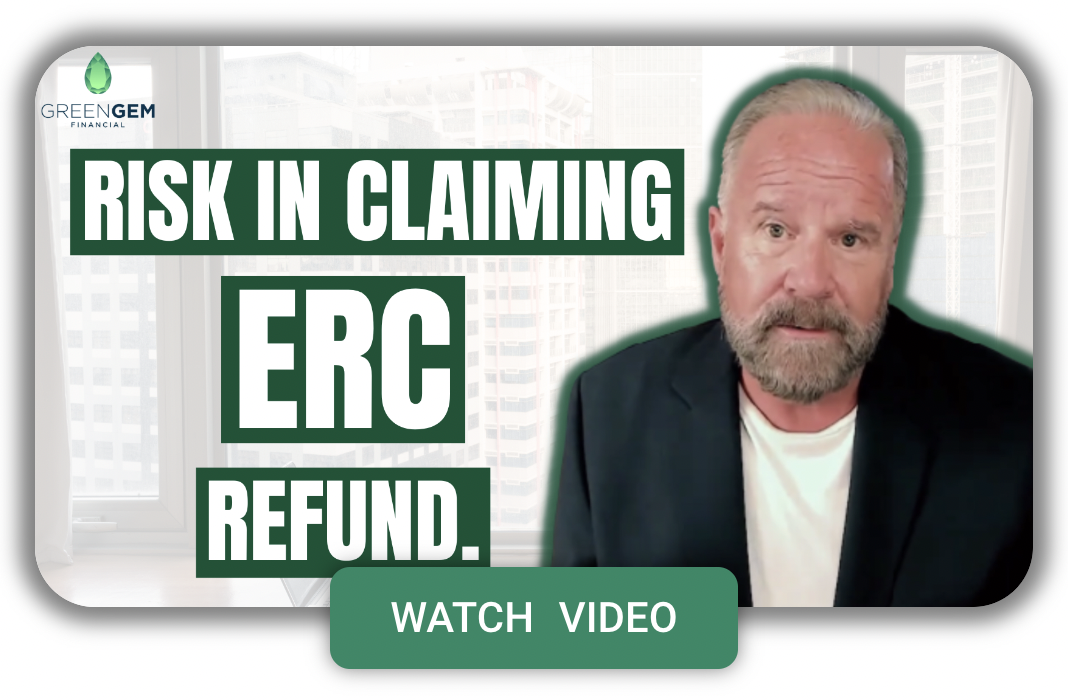The Deadline to file your ERC Tax Refund
See New IRS Announcement:
Limited Time Left to Apply
Tax Credit Countdown
Limited Time Left to Apply
Translate in Español

Trusted Tax Credit Specialists
Claim Tax Credits with Confidence
Made personnel adjustments due to issues with supply chain, capacity, project delays, or other COVID-related challenges? You may qualify to file for Employee Retention Credits (ERC).
Check your eligibility now!
There's NO cost or obligation to see if you are eligible.

Trusted Tax Credit Specialists
Claim Tax Credits with Confidence
Made personnel adjustments due to issues with supply chain, capacity, project delays, or other COVID-related challenges? See if you qualify.
Check your eligibility now!
There's NO cost or obligation to see if you are eligible.
It's Your Money!
Start By Filing Below.
Got A Question?
Request A Callback Now

If your business experienced a partial or complete shutdown due to a governmental order, or had a severe decline in gross receipts, your business could qualify for a tax refund. Unlike a tax deduction or a loan these tax refunds are a tax rebate of the taxes you’ve already paid, putting cash back directly back into your business.
It's Your Money!
What are Employee Retention Credits?

The Employee Retention Credits, or ERC, was introduced in 2020 as part of the CARES Act to provide relief to businesses who were able to keep their employees on the payroll in 2020 and 2021.
If your business experienced a partial or complete shutdown due to a governmental order, or had a severe decline in gross receipts, your business could qualify for ERC. Unlike a tax deduction or a loan, ERC is a tax rebate of the taxes you’ve already paid, putting cash back directly back into your business.
Start By Filing Below.




How to Apply for Tax Credits.
3 Steps to claim your refund!

STEP 1
Complete your application!
We are thorough and efficient. Schedule your complimentary, no obligation consultation.

STEP 2
Documentation and Approval
With our personalized services, you can claim your refund with complete peace of mind.

STEP 3
Receive US Treasury Checks.
Up to $26,000/employee that you can use for whatever you choose.
Our Success Stories

Nonprofit
490 Employees
Total Refund
$8,378,966.40

Healthcare
26 Employees
Total Refund
$129,788.50

Supply Chain
62 Employees
Total Refund
$1,574,443.93

Automotive
15 Employees
Total Refund
$83,408.50

Trash Pickup
32 Employees
Total Refund
$362,450.00

Landscaping
26 Employees
Total Refund
$215,271.00

Restoration Services
38 Employees
Total Refund
$436,510.30

Exterior Cleaning
9 Employees
Total Refund
134,323.00

Motorcycle Builder
25 Employees
Total Refund
$312,050.50

Vehicle Wraps
7 Employees
Total Refund
$114,398.40

Insurance Agency
8 Employees
Total Refund
$151,412.50

Marketing Agency
22 Employees
Total Refund
$486,025.20
How to Apply for ERC.
3 Steps to claim your refund!

STEP 1
Complete your application!
It’s fast and efficient. Schedule your complimentary, no obligation consultation.

STEP 2
Documentation and Approval
With our personalized services, you can claim your ERC with complete peace of mind.

STEP 3
Receive US Treasury Checks.
Up to $26,000/employee that you can use for whatever you choose.
It’s not just another government program – it’s a refund of your payroll taxes during the pandemic. And guess what? You can use the money for anything you want. There are no restrictions. Plus, the amounts tend to be much larger than PPP loans. As experts in this field, we’re here to help you navigate the ins and outs of the ERC.

Already filed for PPP?
The IRS now permits businesses, who previously had to choose between the Paycheck Protection Program (PPP) and the Employee Retention Credit (ERC), to potentially benefit from both stimulus programs. Reach out to our team to ensure you’re not missing out on any available funds!
The federal government took action to aid small businesses during the COVID-19 crisis. In addition to the widely known Paycheck Protection Program, another relief strategy emerged: the Employee Retention Credit. Unlike PPP loans, the ERC rewards businesses for retaining their employees by refunding payroll taxes. And this isn’t just a drop in the bucket, either: eligible employers can receive up to $26,000 per worker. This measure is a smart way to give businesses a boost while simultaneously incentivizing them to keep folks on their payroll.
The Most Common ERC Questions...

Who Qualifies and How Do They Qualify for ERC?
Did you have a team of 5 or more employees during 2020-2021? You may be eligible if you were impacted by COVID due to more than 12,000 regulations. Watch to learn more.

Can I Still Qualify for the ERC if I had PPP Loans Forgiven?
There are stringent guidelines in place. Navigating the intricate and complex requirements led us to develop custom software to guarantee you receive the maximum credits possible.

Don't Believe It If You Were Told You Don't Qualify for the ERC!
95% of the businesses we collaborate with qualify for refunds. Add to that, about 50% of them had no idea that they were eligible. Let us help you uncover the funds you deserve.

What are the Risks with Claiming the ERC Refund?
The importance of using a specialist to file cannot be underestimated.
It’s crucial to enlist the help that can guide you through this intricate process with confidence and ease.
Why Choose Green Gem Financial?
What is the Employee Retention Credit (ERC)?
It is a partially refundable tax credit that businesses can claim for qualified wages paid to employees during the COVID-19 pandemic. The ERC is a refundable tax credit, which means that businesses can get a refund for the amount of the credit that exceeds their tax liability. However, the ERC is also a non-refundable tax credit, which means that businesses cannot get a refund for the credit if it reduces their tax liability to zero.
What businesses may be eligible for the ERC?
Under the CARES Act of 2020, businesses may be eligible for the ERC if they had employees and operated a trade or business, including tax-exempt organizations. However, with limited exceptions, it does not apply to governments or their agencies and instrumentalities. A small eligible employer for 2020 is an employer that had 100 or fewer full-time (30 hours per week or more) employees on average per month in 2019, and for 2021 had 500 or fewer full-time employees on average per month in 2019.
Your business may be eligible for the ERC if its operations were fully or partially suspended by governmental COVID-19 orders limiting commerce, travel or group meetings or experienced a significant decline in gross receipts during 2020 or the first three quarters of 2021. If your business started to operate on or after February 15, 2020, it may qualify to claim the ERC for the third or fourth quarters of 2021 as a recovery startup business.
Who is considered a full-time employee (FTE) under the ERC?
According to Section 4980H of the Internal Revenue Code, an FTE is someone who works an average of at least 30 hours per week or 130 hours per month.
What is the deadline to claim my ERC?
Eligible employers can still claim the Employee Retention Credit (ERC) by filing a Form 941X for relevant quarters, even though the ERC calendar period ended December 31, 2021. For all three quarters in 2020, the deadline to apply is April 15, 2024; for all quarters in 2021, the deadline is April 15, 2025.
How do I claim the ERC?
Eligible businesses can retroactively claim the ERC for 2020 and 2021 by filing IRS Form 941-X to amend their filed returns (Form 941) for the quarters during which your business was an eligible employer. It is important to ensure that your Forms 941 for 2020 and 2021 were filed, received, and processed by the IRS prior to filing Form 941X. Unlike Forms 941, Forms 941X cannot be filed electronically. Before you claim the credit, make sure you are equipped with the following information:
- Payroll data
- Personal information (including Employer Identification Number)
- Prior years’ tax returns
- Copies of Form 941 filed for each quarter you plan to claim the ERC
How can Green Gem Financial help me maximize my ERC?
We understand that filing for an employee retention credit can be a daunting task. By filing with us you can rest easy knowing that your information will be handled with care and strict compliance. We pride ourselves in helping small businesses reach their full potential. Let us help you navigate the qualification process transparently and efficiently.
Did your CPA say you don’t qualify for the ERC?
We’re happy to work with your CPA. A decline in revenue may not be required. Many of our customers even had increases in sales, but still experienced disruptions or were negatively impacted. Let us help.
The IRS said I should use a "Trusted CPA"
Our Partner, Thomas McNulty CPA LLC conducts the ERC analysis. They have over 30 years of experience in Princeton, NJ. They are the official tax preparers signing your return.
2023 Green Gem Financial, LLC. All rights reserved.
Why Choose Green Gem Financial?
What is the Employee Retention Credit (ERC)?
It is a partially refundable tax credit that businesses can claim for qualified wages paid to employees during the COVID-19 pandemic.The ERC is a refundable tax credit, which means that businesses can get a refund for the amount of the credit that exceeds their tax liability. However, the ERC is also a non-refundable tax credit, which means that businesses cannot get a refund for the credit if it reduces their tax liability to zero.
What businesses may be eligible for the ERC?
Under the CARES Act of 2020, businesses may be eligible for the ERC if they had employees and operated a trade or business, which includes tax-exempt organizations. However, with limited exceptions, it does not apply to governments or their agencies and instrumentalities. A small eligible employer for 2020 is an employer that had 100 or fewer full-time (30 hours per week or more) employees on average per month in 2019, and for 2021 had 500 or fewer full-time employees on average per month in 2019.
Your business may be eligible for the ERC if its operations were fully or partially suspended by governmental COVID-19 orders limiting commerce, travel or group meetings or experienced a significant decline in gross receipts during 2020 or the first three quarters of 2021. If your business started to operate on or after February 15, 2020, it may qualify to claim the ERC for the third or fourth quarters of 2021 as a recovery startup business.
Who is considered a full-time employee (FTE) under the ERC?
According to Section 4980H of the Internal Revenue Code, an FTE is someone who works an average of at least 30 hours per week or 130 hours per month.
What is the deadline to claim my ERC?
Eligible employers can still claim the Employee Retention Credit (ERC) by filing a Form 941X for relevant quarters, even though the ERC calendar period ended December 31, 2021. For all four quarters in 2020, the deadline to apply is April 15, 2024; for all quarters in 2021, the deadline is April 15, 2025.
How do I claim the ERC?
Eligible businesses can retroactively claim the ERC for 2020 and 2021 by filing IRS Form 941-X to amend their filed returns (Form 941) for the quarters during which your business was an eligible employer. It is important to ensure that your Forms 941 for 2020 and 2021 were filed, received, and processed by the IRS prior to filing Form 941X. Unlike Forms 941, Forms 941X cannot be filed electronically. Before you claim the credit, make sure you’re equipped with the following information:
- Payroll data
- Personal information (including Employer Identification Number)
- Prior years’ tax returns
- Copies of Form 941 filed for each quarter you plan to claim the ERC
How can Green Gem Financial help me maximize my ERC?
We understand that filing for an employee retention credit can be a daunting task. By filing with us, though, you can rest easy knowing that your information will be handled with care and strict compliance. We pride ourselves in helping small businesses reach their full potential. Let us help you navigate the qualification process transparently and efficiently.
Did your CPA say you don’t qualify for the ERC?
We’re happy to work with your CPA. A decline in revenue may not be required. Many of our customers even had increases in sales, but still experienced disruptions or were negatively impacted. Let us help.
The IRS said I should use a "Trusted CPA"
Our Partner, Thomas McNulty CPA LLC conducts the ERC analysis. They have over 30 years of experience in Princeton, NJ, they are the official tax preparers signing your return.
2023 Green Gem Financial, LLC. All rights reserved.